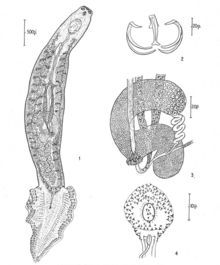| Microcotyle | |
|---|---|

| |
| Microcotyle donavini (Type-species of Microcotyle) | |
| Scientific classification | |
| Domain: | Eukaryota |
| Kingdom: | Animalia |
| Phylum: | Platyhelminthes |
| Class: | Monogenea |
| Order: | Mazocraeidea |
| Family: | Microcotylidae |
| Subfamily: | Microcotylinae |
| Genus: | Microcotyle Van Beneden & Hesse, 1863 |
Microcotyle is a genus which belongs to the phylum Platyhelminthes and class Monogenea. Species of Microcotyle are ectoparasites that affect their host by attaching themselves as larvae on the gills of the fish and grow into adult stage. This larval stage is called oncomiracidium, and is characterized as free swimming and ciliated.
Species of Microcotyle have only one host in their entire life cycle. Different species of Microcotyle inhabit marine and freshwater and they can also infect different species of fishes. They are uniquely characterized by their haptor having a lot of tiny clamps on the lateral margins.
Although not really known to cause that much damage in marine wildlife, some of them are reported to cause agricultural problems like Microcotyle sebastis as an example. Microcotyle sebastis commonly affects Sebastes schlegeli, a maricultured fish in Korea.[1]
- ^ Kim, Ki. H, and Eun. Lee, and Se. Kwon, and Jae. Cho. (2001). Treatment of Microcotyle sebastis infestation in cultured rockfish Sebastes schlegeli by oral administration of praziquantel in combination with cimetidine. Diseases of Aquatic Organisms, 44 (2), pp. 133–136